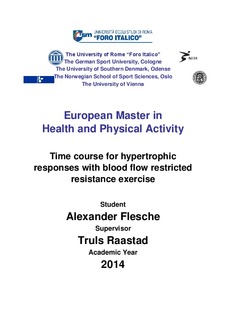| dc.description.abstract | Background: Blood flow restricted resistance exercise (BFRRE) has been shown to increase
muscle size rapidly. However, few studies have reported the exact time course for when
hypertrophic adaptations with BFRRE occurs. This is challenging because it is difficult to
distinguish between the exercise-induced muscle cell swelling associated with BFRRE and
permanent functional hypertrophy. BFRRE with high training frequency could be important
in settings where individuals need to increase their muscle mass fast, but high forces on the
musculo-skeletal system are compromised or even contraindicated. Objective: To investigate
the time course for increases in muscle thickness of m. vastus lateralis (VL) and the cross
sectional area (CSA) of m. rectus femoris (RF) during two weeks of BFRRE with high
training frequency. Method: Nine healthy subjects (age 24±2.1) performed a total of 14 bouts
of unilateral knee extension (on both legs) at 20% of 1RM. Each bout consisted of 4 sets to
failure (a total of +/-80 repetitions). Seven bouts were performed per training week and a 10
day rest period separated the two training weeks. Ultrasound measurements and DOMSanalysis
was carried out every day before training bouts. One repetition maximum (1RM) and
muscle function-tests were investigated pre, day 1, 9, 15, 22 and 29 day. Both training weeks
started with “acute days” (day 1 and 15), consisting of all the aforementioned tests conducted
before and after exercise as well muscle biopsy obtained from VL 1 hour after exercise
Results: Over the entire training period VL muscle thickness increased by 5.7% (right leg)
and 6.4% (left leg). RF CSA increased by 7% (right leg) and 8.8% (left leg). A rapid gradual
increase was observed in both measures of muscle size during the first weel, followed by a
reduction during the rest period, before a similar gradual increase was found in the second
training week. The increase in muscle thickness and CSA was stabilized between post-tests on
day 22 and 29. Maximal isometric strength (MVC) increased significantly with 17.1%,
whereas no significant increase was found in maximal isokinetic torque (+ 2.6%), or 1RM in
knee extension (+1.4%). Conclusion Our findings indicate that one week of BFRRE is
sufficient to increase muscle size. However a large portion of the increases observed in
muscle size during the first week was probably a result of exercise-induced cell swelling. A
more permanent effect on muscle size was found after the second training week (day 19) and
from post-tests on day 22 to day 29, indicated by a plateau observed between these time
points. Significant increases was found in MVC, but not in isokinetic strength or 1RM. | nb_NO |
